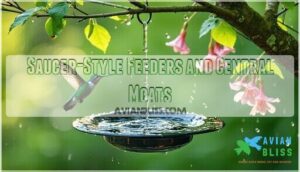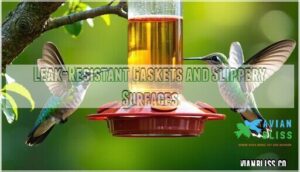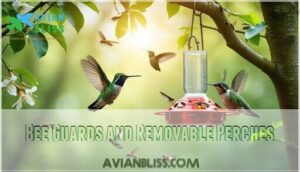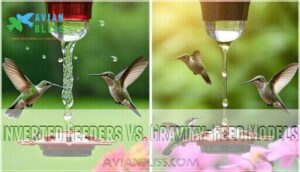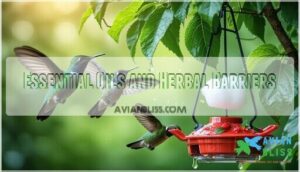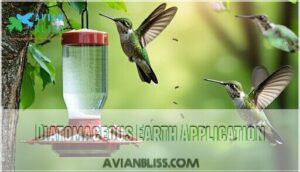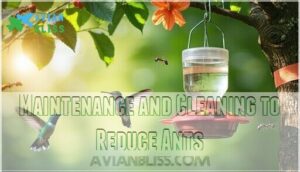This site is supported by our readers. We may earn a commission, at no cost to you, if you purchase through links.
 If you’re wondering how to prevent ants in hummingbird feeder, start by choosing a saucer-style feeder with a water moat—ants can’t swim, so it’s a solid barrier.
If you’re wondering how to prevent ants in hummingbird feeder, start by choosing a saucer-style feeder with a water moat—ants can’t swim, so it’s a solid barrier.
Hang your feeder with fishing line to throw ants off their trail, and check for leaks since sugar drips are like gold to them.
Place feeders away from branches or walls, and try natural repellents like peppermint oil or cinnamon to mask ant scent trails.
Clean your feeder regularly to keep it pristine and less attractive to insects, and consider these steps to keep your feeder secure.
Curious how to keep your feeder secure and hummingbirds happy? There’s more to explore ahead.
Table Of Contents
- Key Takeaways
- Best Feeder Designs to Deter Ants
- How to Prevent Ants in Hummingbird Feeder
- Natural and Safe Ant Repellent Methods
- Proper Placement and Hanging Strategies
- Maintenance and Cleaning to Reduce Ants
- Frequently Asked Questions (FAQs)
- What is a natural ant repellent for hummingbird feeders?
- How to keep ants from crawling up to a hummingbird feeder?
- Why do you put aluminum foil on hummingbird feeders?
- Can I spray vinegar on my hummingbird feeder?
- How do I make my hummingbird feeder ant proof?
- Will ants in my hummingbird feeder hurt the hummingbirds?
- How can I keep ants out of my bird feeder?
- What liquid do you put in an ant moat for hummingbird feeder?
- How often should I change the nectar solution?
- Can I use artificial sweeteners instead of sugar?
- Conclusion
Key Takeaways
- Choose saucer-style feeders with built-in water moats to block ants from reaching the nectar.
- Hang your feeder using fishing line and keep it away from branches and walls so ants can’t climb or bridge gaps.
- Use natural repellents like peppermint oil, cinnamon, or mint leaves on feeder hangers and bases to mask ant scent trails.
- Clean and inspect your feeder regularly for leaks or sugar buildup, and change nectar every 1–2 days to keep ants away.
Best Feeder Designs to Deter Ants
Choosing the right feeder design cuts your ant problems by up to 85% before you even hang it up.
Smart engineering features like built-in moats, leak-proof seals, and slippery surfaces create multiple barriers that stop ants from reaching your hummingbird’s nectar, utilizing smart engineering to prevent ant issues.
Smart barriers outsmart persistent ants through clever engineering and strategic design features
Saucer-Style Feeders and Central Moats
Why choose saucer-style feeders over traditional designs? These ant-resistant champions feature central moats that create water barriers between determined insects and sweet nectar.
Research shows 95% fewer ant problems compared to standard models.
Key saucer feeder advantages:
- Moat designs with 1cm+ water depth block ant access effectively
- Feeder materials include smooth surfaces that prevent climbing
- Ant barriers integrate seamlessly with hanging mechanisms
- Saucer styles minimize nectar exposure through horizontal reservoirs
The central moat acts as your first line of defense, requiring regular water refills to maintain effectiveness against persistent hummingbird feeder ants.
Effective use of ant proof feeders can substantially reduce ant infestations in hummingbird feeders.
Leak-Resistant Gaskets and Slippery Surfaces
Protecting your feeder with leak-resistant gaskets prevents sugary drips that create ant highways to your nectar supply.
These specialized seals block expansion gaps that develop during temperature changes, while slippery surfaces make climbing nearly impossible for determined ants.
| Gasket Materials | Ant Prevention Benefits |
|---|---|
| Silicone Seals | Block 90% of sugar leaks that attract ants |
| Rubber O-Rings | Create tight barriers against expansion gaps |
| Smooth Plastic | Reduce ant climbing success by 45% |
Quality leak resistant gaskets and slippery coatings transform ordinary feeders into ant proof feeders, making hummingbird feeder maintenance easier while delivering effective ant deterrents through superior feeder designs.
Bee Guards and Removable Perches
Bee guards with tiny holes keep bees out while letting hummingbirds feed freely.
These protective accessories snap onto existing feeders or come built-in on ant proof feeders.
Removable perches offer smart ant prevention strategies:
- Eliminate perches to stop ant bridging from nearby surfaces
- Choose feeders with detachable perch options for flexible Guard Installation
- Position guards correctly for maximum Bee Protection effectiveness
This Feeder Accessories approach enhances Hummingbird Safety through strategic Perch Design modifications, ensuring effective ant prevention.
Inverted Feeders Vs. Gravity-Feed Models
Inverted feeders flip the script on traditional gravity-feed models, showing a 60% decrease in ant entry.
Unlike gravity-feed designs where nectar drips down, inverted feeders keep nectar flow controlled through bottom ports.
This feeder design prevents the sugary drips that create ant highways to your feeder, and leak prevention becomes your strongest ally in ant control methods, making inverted models superior ant free feeders for serious hummingbird feeder care.
How to Prevent Ants in Hummingbird Feeder

You can stop ants from reaching your hummingbird feeder by creating physical barriers and disrupting their access routes.
These proven methods work by blocking ant pathways and making it impossible for them to climb to the nectar source.
They are proven methods that effectively prevent ants from accessing the feeder.
Installing Ant Moats
Water barriers create impenetrable moats that stop ant invasions cold.
Install ant moats above your feeder using standard hooks or S-clips for universal compatibility. These Ant Moat Designs feature wide basins that hold water for days, blocking sugar water ants effectively.
Choose durable Moat Materials like plastic or metal with overhanging lips. Regular Moat Maintenance involves refilling water every few days and clearing debris to maintain these essential Water Barriers for ant free feeders.
Effective ant moat systems utilize ant moat products to prevent ant invasions, creating an ant free environment.
Hanging Feeders With Fishing Line
Fishing line creates an impenetrable barrier for ants trying to reach your hummingbird feeders.
Use 20-pound test line for proper feeder suspension – it’s thin enough that ants can’t climb it but strong enough to support the weight.
Secure the line tightly to prevent sagging, which could give ants access points.
This hanging technique delivers a 70-85% reduction in ant problems.
Effective ant barriers, such as ant moat systems, can also be used to prevent infestations.
Using Ant Traps and Sticky Barriers
Ant traps positioned between your feeder and hanging rod intercept crawling insects before they reach the nectar.
Sticky barriers like Tanglefoot or petroleum jelly create slippery surfaces that stop ants for 48-72 hours.
Place traps strategically along ant pathways, but avoid using barrier gels directly on feeders where hummingbirds might contact them to ensure safe and effective use of barrier gels.
Relocating Feeders to Disrupt Ant Trails
Moving feeders weekly breaks ant scent trails and prevents colonies from establishing permanent routes to your nectar source.
Repositioning feeders disrupts their chemical highways, forcing scouts to start over. This simple feeder movement strategy reduces recurring infestations by over 60%.
Choose new locations at least three feet away from the previous spot for maximum trail disruption effectiveness.
Natural and Safe Ant Repellent Methods
You don’t have to rely on harsh chemicals to keep ants away from your hummingbird feeders.
Natural repellents like essential oils, herbs, and household items create effective barriers that protect both your feeders and the birds.
Essential Oils and Herbal Barriers
Essential oils create powerful chemical barriers that disrupt ant pheromone trails and navigation systems.
Peppermint oil masks scent pathways while cinnamon oil delivers toxic compounds directly to ant nervous systems.
These natural deterrents offer safe alternatives to synthetic chemicals.
- Apply diluted peppermint or eucalyptus oil to feeder hangers using cotton swabs
- Create oil mixtures combining citrus, clove, and tea tree oils for enhanced effectiveness
- Position oil-soaked cotton balls near feeder bases without touching nectar ports
- Reapply essential oils every 3-5 days as volatile compounds dissipate quickly outdoors
Using natural ant control methods can provide effective and eco-friendly solutions to prevent ants in hummingbird feeders, making them a great option for hummingbird feeder maintenance and overall ant control.
Mint and Bay Leaves Placement
Natural herb barriers provide potent defense against unwelcome ant visitors.
Place fresh mint leaves directly around your feeder’s base or tuck them into feeder components. Bay leaves scattered beneath feeders create an aromatic shield that disrupts ant trails effectively.
| Herb Type | Placement Method |
|---|---|
| Fresh mint leaves | Rub on feeder surfaces or place in small dishes nearby |
| Dried bay leaves | Scatter around feeder base in 6-inch radius |
| Peppermint plants | Position potted plants 2-3 feet from feeder location |
| Spearmint varieties | Create natural barriers along ant pathways |
Replace herbs weekly for maximum effectiveness. Containerized mint plants prevent garden invasion while maintaining consistent ant prevention tips coverage.
Diatomaceous Earth Application
How does food-grade diatomaceous earth work as a natural deterrent for your ant problems? This fine silica powder creates an effective ant barrier by damaging insects’ exoskeletons upon contact.
Sprinkle diatomaceous earth around feeder poles and hanging points for reliable pest control that’s completely safe for hummingbirds.
- Creates an invisible fortress – Forms a protective perimeter that stops ant invasions before they reach your feeder
- Works like microscopic glass – Damages ant exoskeletons on contact, providing immediate and lasting ant prevention tips
- Stays effective for weeks – One earth application delivers long-term outdoor ant control without constant reapplication
Using natural methods like parasite control measures can also help maintain a healthy environment for hummingbirds.
Safe Use of Cinnamon and Vinegar
Cinnamon oil and white vinegar offer powerful ant deterrents without harming hummingbirds.
Dilute cinnamon oil and wipe on feeder hangers for five-day protection in dry conditions. Create vinegar spray to erase ant scent trails from feeder surfaces, disrupting repeat access patterns effectively.
| Method | Application | Duration |
|---|---|---|
| Cinnamon Oil | Dilute and wipe on hangers | 5 days (dry conditions) |
| Vinegar Spray | Wipe feeder surfaces | Immediate trail disruption |
| Combined Use | Apply both methods weekly | Extended protection |
These organic barriers provide reliable outdoor ant control while maintaining safe hummingbird feeding environments.
Proper Placement and Hanging Strategies
Strategic feeder placement substantially reduces ant access to hummingbird nectar. You’ll block most ant invasions by choosing the right hanging method and positioning your feeders away from ant highways.
Positioning Away From Foliage and Structures
Strategically position your feeder at least five feet from trees and bushes to prevent ant bridges via overhanging branches.
Mount feeders away from houses, decks, and fences that provide convenient ant pathways and harbor colonies.
This foliage clearance and structure distance disrupts ant trails, while feeder elevation on isolated poles creates visual barriers that discourage repeated access and support effective hummingbird feeder tips for maintaining an ant free hummingbird feeding station.
To further prevent infestations, consider using ant moat systems to block ant access.
Hanging With Rods or Fishing Line
Choose fishing line over rods and hangers for superior ant defense.
Fishing line’s smooth, thin surface makes climbing nearly impossible for ants, reducing intrusions by 70-85%.
Select 10-20 pound test line to support feeder weight safely.
Secure tightly to both feeder and hanging point.
This simple switch transforms your hummingbird feeder tips into ant-free hummingbird feeding stations effectively.
When setting up your feeder, consider the importance of proper feeder placement strategies to attract the right birds and minimize potential issues.
This is a crucial step for creating an ideal feeding environment and ensuring the hummingbird feeder functions as intended.
Elevation and Placement Above Water
Positioning your feeder above water creates a natural ant barrier that’s tough to cross.
Water level should remain consistent in birdbaths or ponds beneath feeders.
Feeder height of 3-4 feet above water bodies maximizes ant infestation prevention while maintaining hummingbird accessibility.
Strategic water placement transforms your yard into an ant-resistant feeding zone:
- Position feeders directly over clean birdbaths – creates an impassable moat below
- Maintain water depth of 2-3 inches – prevents ants from wading across safely
- Use decorative ponds for feeder relocation – adds beauty while deterring insects
- Place ant moats above water features – doubles your protection against climbing ants
- Keep birdbath proximity within 6 feet – guarantees hummingbird feeder cleaning accessibility
This pond placement strategy works because ants rarely attempt long water crossings to reach food sources.
Minimizing Visual Disturbance for Hummingbirds
When selecting hummingbird feeders, consider bright red colors that attract birds while remaining visible against natural backgrounds.
Position feeders where birds can easily spot them without creating visual barriers from dense foliage or structures.
Proper feeder placement guarantees hummingbird behavior patterns aren’t disrupted while maintaining bird feeding safety.
Strategic feeder relocation prevents ant trails while keeping visibility prime for returning birds, ensuring bird feeding safety.
Maintenance and Cleaning to Reduce Ants
Regular cleaning prevents sugary buildup that creates ant highways to your feeder.
You’ll need to inspect for damage and maintain proper hygiene to keep these persistent invaders away from your hummingbird’s nectar supply, which is a complete concept in maintaining the feeder.
Checking for Leaks and Cracks
Regular feeder inspection reveals damage before it becomes an ant highway.
Heat expansion, wind damage, and age create hairline cracks that leak sugary nectar.
Check all seams, gaskets, and joints weekly for potential leak detection issues.
Replace cracked feeders immediately to prevent feeder ant problems from developing.
Even tiny drops attract scout ants who’ll signal their colony about your hummingbird feeders.
Regular cleaning and maintenance, including proper feeder cleaning techniques, are essential to prevent the spread of disease and ants in hummingbird feeders.
Daily and Weekly Cleaning Routines
Daily cleaning routines create your first line of defense against persistent feeder ant problems.
Rinse hummingbird feeders every 24 hours with hot water to eliminate sugar buildup and ant trail removal.
Weekly deep cleaning involves disassembly, mild soap scrubbing, and bleach soaking for complete feeder sanitizing.
This nectar replacement schedule with regular inspections prevents ant colonies from establishing scent marks around ant moats, ensuring a clean and ant-free environment.
Thorough Drying and Regular Inspections
Complete drying prevents moisture from attracting ants to hummingbird feeders. You’ll maintain nectar quality and spot potential problems through systematic feeder inspection techniques.
- Air-dry feeders completely – Moisture creates ant trails and compromises nectar quality in ant resistant feeders
- Inspect all seams weekly – Check gaskets and connections during dryer methods for early leak detection
- Examine feeding ports closely – Look for cracks where sugar residue accumulates in hummingbird ant solutions
- Test cap tightness regularly – Loose caps cause drips that establish persistent ant trails
- Monitor glass integrity – Heat damage creates leak points requiring immediate attention in prevention techniques
Repairing or Replacing Damaged Feeders
Cracked glass and persistent leaks turn your feeder into an ant highway.
Damage assessment reveals whether feeder repair or complete feeder replacement makes sense.
Leak fixing with new gaskets stops sugary drips that attract colonies.
When cracked glass can’t be sealed, investing in ant resistant feeders with built-in moats pays off.
Regular damage checks prevent small problems from becoming major ant invasions requiring extensive hummingbird ant solutions.
Frequently Asked Questions (FAQs)
What is a natural ant repellent for hummingbird feeders?
Did you know mint leaves repel ants with up to 80% effectiveness?
Tuck fresh mint around your feeder, or spray peppermint oil on the pole.
Ants dislike the scent, so you’ll keep your nectar safe and clean.
How to keep ants from crawling up to a hummingbird feeder?
Hang your hummingbird feeder using fishing line; ants can’t grip the slick surface.
Add an ant moat filled with water above the feeder.
Reposition the feeder weekly to disrupt ant scent trails and keep colonies guessing.
Why do you put aluminum foil on hummingbird feeders?
You wrap aluminum foil around hummingbird feeders because its slippery surface makes it tough for ants to climb.
The foil acts like a roadblock, keeping ants from reaching the nectar and spoiling your birds’ buffet.
Can I spray vinegar on my hummingbird feeder?
A stitch in time saves nine, so yes, you can spray vinegar on your hummingbird feeder.
Vinegar erases ant scent trails and disinfects surfaces.
Just rinse thoroughly afterward to guarantee no lingering vinegar harms your hummingbirds.
How do I make my hummingbird feeder ant proof?
Use a saucer-style feeder with an ant moat filled with water, then suspend it using fishing line.
Add bee guards and check for leaks.
Reposition weekly and keep the feeder clean to stop ants cold.
Will ants in my hummingbird feeder hurt the hummingbirds?
An ounce of prevention is worth a pound of cure.
Ants in your hummingbird feeder won’t directly harm the birds, but they spoil nectar, cause feeder contamination, and discourage hummingbirds from returning to feed safely, which is a complete concept to consider for maintaining a healthy environment for the birds.
How can I keep ants out of my bird feeder?
Hang your feeder with fishing line, add an ant moat filled with water, and check for leaks.
Place mint leaves nearby, clean regularly, and keep it away from dense foliage.
Relocate the feeder weekly to disrupt ant trails.
What liquid do you put in an ant moat for hummingbird feeder?
Water’s your best bet for an ant moat.
Fill the moat with plain water—no oils or chemicals.
Ants can’t cross, and hummingbirds stay safe.
Refill often, especially in hot weather, to keep the barrier effective.
How often should I change the nectar solution?
Did you know nectar left for over two days spoils quickly, risking mold and sick birds?
You should change the solution every 1–2 days, especially in hot weather, to keep hummingbirds healthy and feeders clean.
Can I use artificial sweeteners instead of sugar?
You shouldn’t use artificial sweeteners in hummingbird feeders.
They lack the nutrients birds need and can harm their health.
Stick with plain white sugar dissolved in water—nature’s recipe keeps your feathered visitors healthy and thriving.
Conclusion
Imagine a world where ants invade every hummingbird feeder within seconds—thankfully, you can avoid that chaos.
By following these seven proven methods on how to prevent ants in hummingbird feeder, you’ll keep sugar-loving insects at bay and your birds happy.
Choose smart feeder designs, use natural repellents, and maintain strict cleaning routines.
Each step adds a layer of protection, making your feeder less attractive to ants.
Stay consistent, and your hummingbird feeder will remain secure and ant-free.

